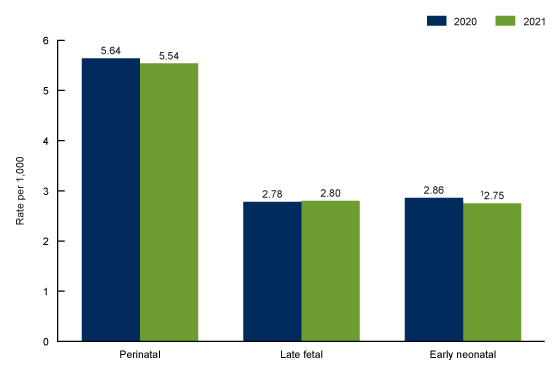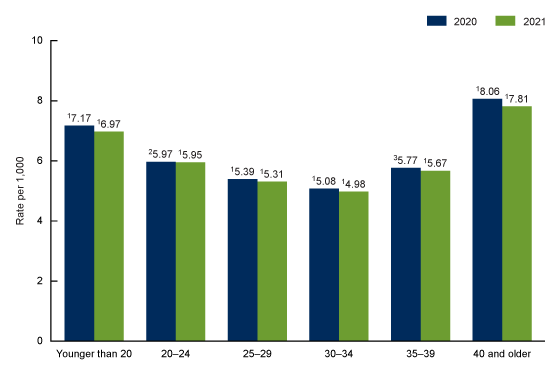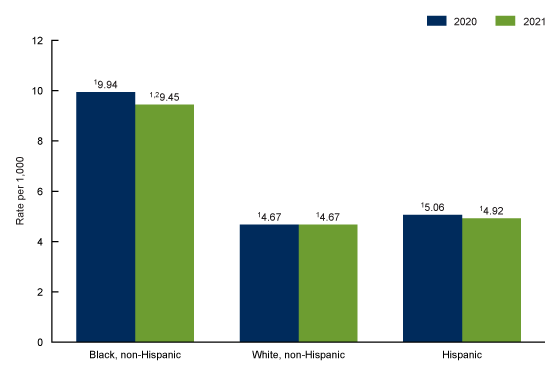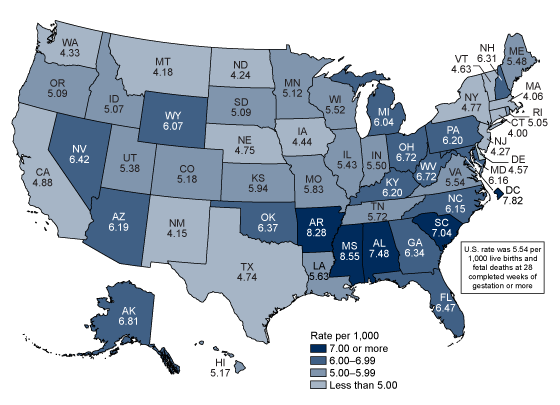Perinatal Mortality in the United States, 2020–2021
- Key findings
- From 2020 to 2021, the early neonatal mortality rate declined; changes in perinatal and late fetal mortality rates were not significant.
- Declines in perinatal mortality rates were not significant for all maternal age groups from 2020 to 2021.
- Perinatal mortality rates declined for Black non-Hispanic females from 2020 to 2021.
- Perinatal mortality rates declined in two states and were essentially unchanged for most U.S. jurisdictions in 2021 compared with 2020.
- Summary
Data from the National Vital Statistics System
- The U.S. perinatal mortality rate was 5.54 perinatal deaths per 1,000 live births and late fetal deaths in 2021, a nonsignificant decline from the rate of 5.64 in 2020.
- The late fetal mortality rate, one of the components of perinatal mortality, was essentially unchanged, while the early neonatal mortality rate, the other component, declined by 4% from 2020 (2.86) to 2021 (2.75).
- Declines in perinatal mortality rates by age of mother were not significant.
- The perinatal mortality rate declined for Black females from 2020 to 2021; the rate for Hispanic females declined, but not significantly, while the rate for White females was unchanged.
- Compared with 2020, perinatal mortality rates declined in two states and were essentially unchanged for 48 states and the District of Columbia in 2021.
Perinatal mortality (late fetal deaths at 28 completed weeks of gestation or more and early neonatal deaths younger than age 7 days) can be an indicator of the quality of health care before, during, and after delivery, and of the health status of the nation (1,2). The U.S. perinatal mortality rate declined 30% from 1990 through 2011, was stable from 2011 through 2016, and declined 4% from 2017 through 2019 (1,3–5). This report describes changes in perinatal mortality, as well as its components, late fetal and early neonatal mortality, from 2020 to 2021, during the COVID-19 pandemic. Also shown are perinatal mortality rates by mother’s age, the three largest race and Hispanic-origin groups, and state for 2021 compared with 2020.
Keywords: perinatal death, trends, race and ethnicity, age, National Vital Statistics System
From 2020 to 2021, the early neonatal mortality rate declined; changes in perinatal and late fetal mortality rates were not significant.
- The perinatal mortality rate was 5.54 in 2021, a nonsignificant decline from the 2020 rate of 5.64 (Figure 1).
- The early neonatal mortality rate declined by 4% from 2.86 in 2020 to 2.75 in 2021.
- The late fetal mortality rate was essentially unchanged from 2020 (2.78) to 2021 (2.80).
Figure 1. Perinatal, late fetal, and early neonatal mortality rates: United States, 2020–2021

1Significant difference from 2020 (p < 0.05).
NOTES: Perinatal mortality rate is the number of fetal deaths at 28 completed weeks of gestation or more and infant deaths younger than age 7 days per 1,000 live births and fetal deaths at 28 completed weeks of gestation or more. Late fetal mortality rate is the number of fetal deaths at 28 completed weeks of gestation or more per 1,000 live births and fetal deaths at 28 completed weeks of gestation or more. Early neonatal mortality rate is the number of infant deaths younger than age 7 days per 1,000 live births. Access data table for Figure 1.
SOURCE: National Center for Health Statistics, National Vital Statistics System, natality data file.
Declines in perinatal mortality rates were not significant for all maternal age groups from 2020 to 2021.
- The perinatal mortality rate declined for all maternal age groups from 2020 to 2021; however, changes were not significant (Figure 2).
- Age-specific perinatal mortality rates decreased with age for maternal age groups younger than 20 (6.97 in 2021) through 30–34 (4.98) and then increased among older women; the rate was highest among women age 40 and older (7.81).
Figure 2. Perinatal mortality rate, by age of mother: United States, 2020–2021

1Significant difference from other age groups (p < 0.05).
2Significant difference from other age groups except 35–39 (p < 0.05).
3Significant difference from other age groups except 20–24 (p < 0.05).
NOTES: Perinatal mortality rate is the number of fetal deaths at 28 completed weeks of gestation or more and infant deaths younger than age 7 days per 1,000 live births and fetal deaths at 28 completed weeks of gestation or more in a specified age group. Access data table for Figure 2.
SOURCE: National Center for Health Statistics, National Vital Statistics System, natality data file.
Perinatal mortality rates declined for Black non-Hispanic females from 2020 to 2021.
- The perinatal mortality rate declined 5% for Black non-Hispanic (subsequently, Black) females from 9.94 in 2020 to 9.45 in 2021 (Figure 3).
- From 2020 to 2021, the perinatal mortality rate was unchanged for White non-Hispanic (subsequently, White) females (4.67); the decline in the rate for Hispanic females (5.06 to 4.92) was not significant.
- The perinatal mortality rate for Black females was about twice as high as the rates for both Hispanic and White females for both years. The rate for Hispanic females was 5%–8% higher than the rate for White females for both years.
Figure 3. Perinatal mortality rate, by race and Hispanic origin of mother: United States, 2020–2021

1Significant difference from other race and Hispanic-origin groups (p < 0.05).
2Significant difference from 2020 (p < 0.05).
NOTES: Perinatal mortality rate is the number of fetal deaths at 28 completed weeks of gestation or more and infant deaths younger than age 7 days per 1,000 live births and fetal deaths at 28 completed weeks of gestation or more in a specified race and Hispanic-origin group. Access data table for Figure 3.
SOURCE: National Center for Health Statistics, National Vital Statistics System, natality data file.
Perinatal mortality rates declined in two states and were essentially unchanged for most U.S. jurisdictions in 2021 compared with 2020.
- Perinatal mortality rates for 2021 ranged from a low of 4.00 in Connecticut to a high of 8.55 in Mississippi (Figure 4).
- Compared with the U.S. rate of 5.54, the perinatal mortality rate was higher in 14 states, lower in 9 states, and not significantly different for 27 states and the District of Columbia.
- Perinatal mortality rates declined by 17% in New Jersey (from 5.16 to 4.27) and 14% in Wisconsin (from 6.42 to 5.52) but were essentially unchanged in 48 states and the District of Columbia in 2021 compared with 2020.
Figure 4. Perinatal mortality rate, by state: 2021

NOTES: Rate per 1,000 live births and fetal deaths at 28 completed weeks of gestation or more. Access data table for Figure 4.
SOURCE: National Center for Health Statistics, National Vital Statistics System, natality data file.
Summary
After declining 4% from 2017 through 2019, the perinatal mortality rate declined, but not significantly, from 2020 (5.64) to 2021 (5.54), the late fetal mortality rate was essentially unchanged at 2.80, and the early neonatal mortality rate declined 4% from 2.86 to 2.75 (5,6). Rates for Black females declined by 5% from 2020 to 2021, while the decline for Hispanic females was not significant and the rate for White females was unchanged. Declines observed in rates for the maternal age groups were not significant. Perinatal rates declined by 14%–17% for two states from 2020 to 2021; rates in the remaining jurisdictions were essentially unchanged. As seen in previous years, the perinatal mortality rate for Black females was about twice as high as that for White and Hispanic females for both 2020 and 2021 (4,5).
Definitions
Late fetal death: A fetal death at 28 completed weeks of gestation or more.
Late fetal mortality rate: Number of fetal deaths at 28 completed weeks of gestation or more per 1,000 live births and fetal deaths at 28 completed weeks of gestation or more.
Early neonatal death: Death of a live-born infant younger than age 7 days.
Early neonatal mortality rate: Number of infant deaths younger than age 7 days per 1,000 live births.
Perinatal death: Fetal deaths at 28 completed weeks of gestation or more and infant deaths younger than age 7 days.
Perinatal mortality rate: Number of fetal deaths at 28 completed weeks of gestation or more and infant deaths younger than 7 days per 1,000 live births and fetal deaths at 28 completed weeks of gestation or more.
Data sources and methods
This report uses data from the Fetal Death Data File and the Linked Birth/Infant Death Data File from the National Vital Statistics System (NVSS). The national vital statistics fetal death data file includes information from all reports of fetal death filed in the 50 states, the District of Columbia, and the U.S. territories. Although reporting requirements for fetal deaths vary somewhat by state, fetal mortality rates from NVSS generally represent fetal deaths of 20 weeks of gestation or more (1). Fetal death data from NVSS are available by a wide range of maternal and infant characteristics (7). The Linked Birth/Infant Death Data File provides information on infant deaths and live births in the United States (8). Fetal Death and Linked Birth/Infant Death data sets are available from: https://www.cdc.gov/nchs/data_access/vitalstatsonline.htm.
Race and Hispanic origin are reported separately on the report of fetal death. The race and Hispanic-origin groups shown in this report follow the 1997 Office of Management and Budget standards and differ from the bridged-race categories in reports before 2018 (9,10). These groups are the three largest race and Hispanic-origin groups (Black, Hispanic, and White).
The differences between rates noted in the text are statistically significant at the 0.05 level unless otherwise noted. Comparisons between state rates and U.S. rates take into account the individual state’s contribution to the U.S. rate. Therefore, each state rate is compared with a unique U.S. rate independent of the state’s contribution to the total U.S. rate. Some state-specific rates are based on small numbers which may limit the ability to detect statistically significant differences by year.
About the authors
Claudia P. Valenzuela, Elizabeth C.W. Gregory, and Joyce A. Martin are with the National Center for Health Statistics, Division of Vital Statistics.
References
- MacDorman MF, Gregory ECW. Fetal and perinatal mortality: United States, 2013. National Vital Statistics Reports; vol 64 no 8. Hyattsville, MD: National Center for Health Statistics. 2015.
- World Health Organization. Neonatal and perinatal mortality: Country, regional and global estimates. 2006.
- MacDorman MF, Kirmeyer SE, Wilson EC. Fetal and perinatal mortality, United States, 2006. National Vital Statistics Reports; vol 60 no 8. Hyattsville, MD: National Center for Health Statistics. 2012.
- Gregory ECW, Drake P, Martin JA. Lack of change in perinatal mortality in the United States, 2014–2016. NCHS Data Brief, no 316. Hyattsville, MD: National Center for Health Statistics. 2018.
- Valenzuela CP, Gregory ECW, Martin JA. Decline in perinatal mortality in the United States, 2017–2019. NCHS Data Brief, no 429. Hyattsville, MD: National Center for Health Statistics. 2022. DOI: https://dx.doi.org/10.15620/cdc:112643.
- National Center for Health Statistics. User guide to the period/cohort linked birth/infant death public use file (published annually).
- National Center for Health Statistics. Fetal death public-use file (published annually).
- National Center for Health Statistics. Linked birth/infant death public-use file (published annually).
- Office of Management and Budget. Race and ethnic standards for federal statistics and administrative reporting. Statistical Policy Directive 15. 1977.
- Office of Management and Budget. Revisions to the standards for the classification of federal data on race and ethnicity. Fed Regist 62(210):58782–90. 1997.
Suggested citation
Valenzuela CP, Gregory ECW, Martin JA. Perinatal mortality in the United States, 2020–2021. NCHS data brief, no 489. Hyattsville, MD: National Center for Health Statistics. 2023. DOI: https://dx.doi.org/10.15620/cdc:134756.
Copyright information
All material appearing in this report is in the public domain and may be reproduced or copied without permission; citation as to source, however, is appreciated.
National Center for Health Statistics
Brian C. Moyer, Ph.D., Director
Amy M. Branum, Ph.D., Associate Director for Science
Division of Vital Statistics
Paul D. Sutton, Ph.D., Acting Director
Andrés A. Berruti, Ph.D., M.A., Associate Director for Science